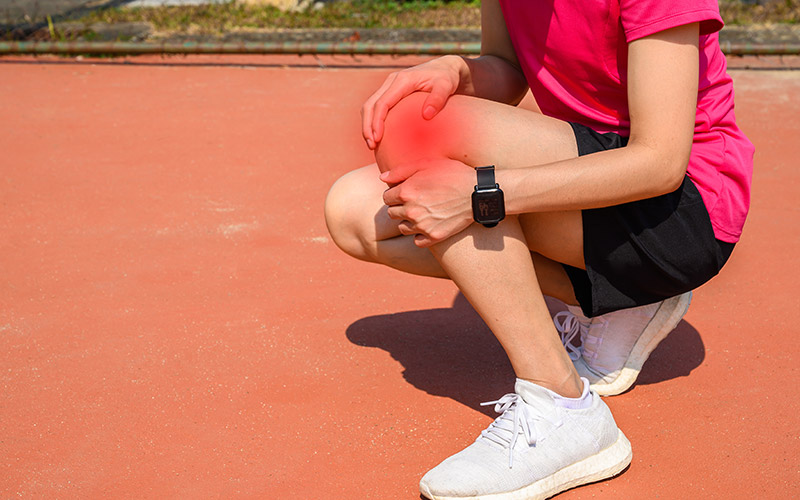
What is ITB?
The iliotibial band, ITB for short, is a structure that begins at the hips and travels down to the knee attaching into the knee. At the hip, multiple muscles including the tensor fascia latae, the gluteus maximus, the gluteus medius, and more, insert into the ITB. The ITB becomes a thick, fibrous band of fascia that extends to the knee where it attaches into multiple structures providing stability, support, and an energy storage system. The ITB, due to its multiple attachments sites both proximally and distally, may cause pressure in a number of different structures.
In the hip, the ITB may cause pressure at the bursae surrounding the greater trochanter which may lead to pain and soreness in the area known as “Greater Trochanteric Pain Syndrome”. At the knee, iliotibial band syndrome may be present with pain slightly above the lateral joint line. Additionally, the ITB’s attachment to the kneecap may cause for altered patellar traction during functional mobility leading to pain anteriorly in the knee; poor patellar tracking can lead to a condition known as patella femoral pain syndrome and tightness of the ITB and associated structures is thought to be a contributing factor.
What is iliotibial band syndrome (ITBS)?
A common injury in athletic populations that is a result of inflammation of the distal portion of the ITB (the area of the ITB inserting closest to the knee. During activities that cause repetitive flexion and extension of the hip and knee, the ITB may shift and slide over structures such as the greater trochanter and lateral femoral epicondyle which can lead to friction causing inflammation and pain. This condition is very common in athletes that participate in distance related activities that require repetitive forward and backward movement of the legs such as running and bicycling.
Those that are suffering from ITBS may have pain at the lateral knee, usually just above the joint line. Pain occasionally radiates and may improve with discontinuing the aggravating activity. Popping is not uncommon at the lateral knee and diagnostic imaging is rarely necessary.
Conservative treatment is typically sufficient although in rare cases, surgery may be performed in recurrent cases.
Conservative Treatment of ITBS
With ITBS, there are many conservative treatment options available and there is no individual protocol that is utilized for treatment of the condition and underlying symptoms. Many different approaches have been utilized with good success depending on patient presentation
Studies have demonstrated that initially, rest is best in the acute stages of ITBS. As the issue becomes more chronic, additional methods of treatment may be utilized including stretching, pain management, strengthening, and modification of habits/technique with return to activity. Medication may be utilized (anti-inflammatory, analgesic, corticosteroid) if indicated and beneficial results have demonstrated with use. Alteration of sport performance (changing shoes/equipment, changing environment of activity, analyzing and modifying technique) has also helped with symptom management and treatment of this condition.
Those looking to return to sport related activity are generally able to return to full sporting performance after 4-6 months in most cases.
Surgical Treatment of ITBS
Occasionally, when an individual has been suffering from chronic ITBS that has not responded to conservative treatment, surgical intervention may be considered. Resection of lateral synovial recess is a common arthroscopic technique utilized that seems to aid with improvement of symptoms. Transection of posterior half of the ITB and bursectomy have also been utilized in chronic cases and havfe shown promising results as well.
Typically, surgical care of ITBS is only utilized in cases where patients have already undergone conservative treatments without success and continue to have irritations despite continued treatment.
What Can PT Do For My ITBS?
Physical therapy is a wonderful option for those seeking conservative care for the treatment of knee pain and hip pain related to ITBS. While ITBS primarily affects the knee and causes pain just above the lateral knee, a tight ITB may also contribute to abnormal movement of the kneecap (poor patellar tracking), pain in the hip (as the ITB rubs on the greater trochanter and associated bursa), altered balance, and altered gait. With PT, a proper program consisting of stretching, strengthening, balance training, soft tissue work, and more can be utilized to aid with improved quality of movement. The more efficiently an individual is able to move, the less chance they will have of causing irritation due to the ITB.
At ProActive PT, we assess each individual to determine the underlying conditions that may be contributing to one’s symptoms and work directly with that individual to address impairments that may be factors in their symptomatology. We believe that each patient should be treated as an individual and will do our best to determine which treatment methods may be best for you!
Sources:
Beals C, Flanigan D. A Review of Treatments for Iliotibial Band Syndrome in the Athletic Population. J Sports Med (Hindawi Publ Corp). 2013;2013:367169. doi:10.1155/2013/367169
Fredericson, M., Wolf, C. Iliotibial Band Syndrome in Runners. Sports Med 35, 451–459 (2005) doi:10.2165/00007256-200535050-00006
Hudson Z, Darthuy E. Iliotibial band tightness and patellofemoral pain syndrome: A case-control study. Manual Therapy, Volume 14, Issue 2. 2009.Pages 147-151, ISSN 1356-689X. https://doi.org/10.1016/j.math.2007.12.009. (http://www.sciencedirect.com/science/article/pii/S1356689X07001804)
Williams, B., Cohen, S. Greater Trochanteric Pain Syndrome: A Review of Anatomy, Diagnosis and Treatment. Anesthesia & Analgesia: Volume 108 – Issue 5 – p 1662-1670. May 2009. doi: 10.1213/ane.0b013e31819d6562. https://journals.lww.com/anesthesia-analgesia/Fulltext/2009/05000/Greater_Trochanteric_Pain_Syndrome__A_Review_of.49.aspx
Fairclough, J., Hayashi, K., Toumi, H., Lyons, K., Bydder, G., Phillips, N., Bes, T.M., Benjamin, M. Is iliotibial band syndrome really a friction syndrome? Journal of Science and Medicine in Sport, Volume 10, Issue 2. 2007. Pages 74-76. ISSN 1440-2440. https://doi.org/10.1016/j.jsams.2006.05.017. http://www.sciencedirect.com/science/article/pii/S1440244006001174

